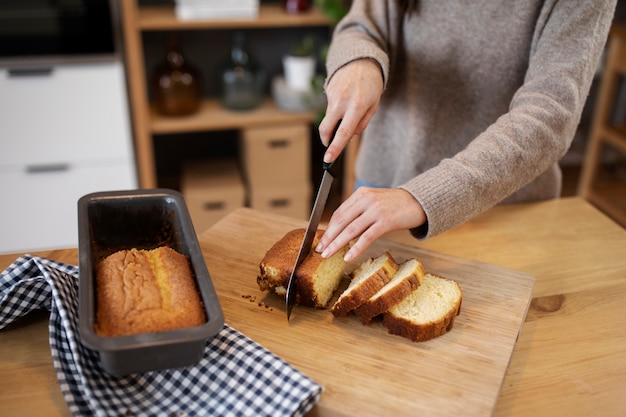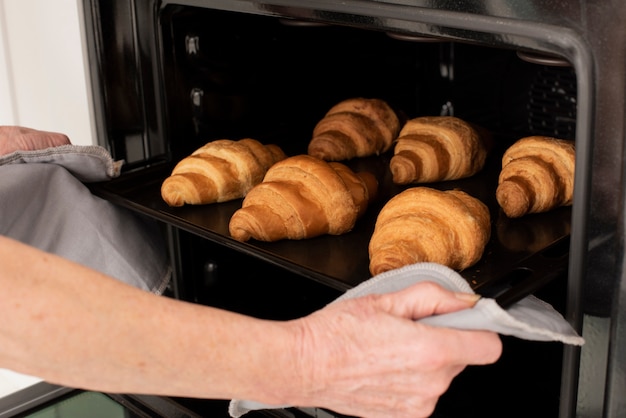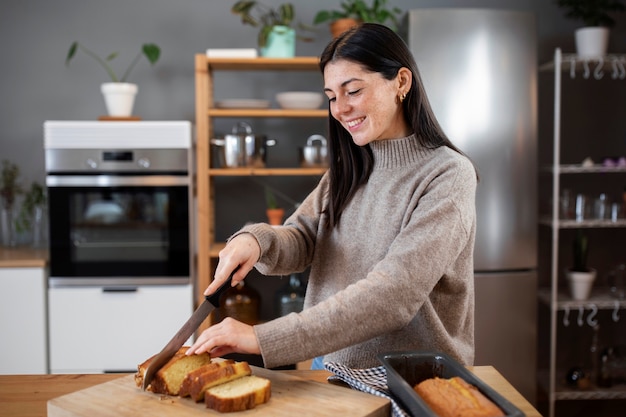Ah, meatloaf. The very word conjures up images of comfort food, a hearty, homey dish that reminds us of happy meals and loving hands in the kitchen. But achieving that perfect meatloaf, juicy and flavorful, can be a bit of a culinary puzzle, especially when it comes to baking time. You don't want it undercooked, and heaven forbid, a dry, overdone brick!
Over the years, I've made my fair share of meatloaf, some spectacular successes bursting with flavor and tender to the core, others, well, let's just say they weren't quite winners. Through trial and error, I've learned a thing or two about nailing the perfect bake, and I'm thrilled to share my wisdom with you. This isn't just about following a recipe, it's about understanding what makes a great meatloaf, and how to consistently achieve that delicious result.
(Part 1) The Foundations of a Great Meatloaf

Before we delve into the intricacies of timing, let's lay a strong foundation. You see, the secret to a truly fantastic meatloaf lies in the right ingredients, the perfect blend, and the ideal cooking environment.
The Heart of the Matter: Choosing the Right Meat
The foundation of any great meatloaf is, of course, the meat. I've experimented with all sorts, from classic beef and pork to lamb and even turkey. Each brings its own unique flavor profile and texture. For a traditional, crowd-pleasing meatloaf, you can't go wrong with a blend of ground beef and pork. The beef provides a rich, hearty base, while the pork adds moisture and tenderness. It's a winning combination that delivers a satisfyingly juicy result. If you're feeling adventurous, consider adding a touch of ground veal or lamb for an extra layer of depth and complexity.
The Magic of Binding and Flavor Boosters
Now, let's talk about the magical ingredients that hold the meatloaf together and elevate the flavor to new heights. This is where things get exciting! Eggs are absolutely essential, acting as the culinary glue that binds everything together, creating a cohesive and stable loaf. Breadcrumbs are also crucial, soaking up any excess moisture while adding texture and a slight crispness. But don't be afraid to experiment with additional ingredients. Finely chopped onions, fresh herbs like parsley or thyme, a sprinkle of garlic, or even a touch of grated cheese can add a wonderful depth of flavor, transforming your meatloaf into a truly unique creation.
Shape Matters: Getting the Perfect Loaf
The shape and size of your meatloaf are critical factors for even cooking. For a classic loaf shape, you'll need a baking dish that comfortably accommodates it, leaving some space around the edges for air circulation and even browning. As for the size, a good rule of thumb is to aim for a loaf that's about 2 inches thick. This ensures that heat reaches the center efficiently, resulting in a consistently cooked and delicious meatloaf.
(Part 2) Prepping Your Meatloaf for Baking Success

Now that you've gathered your ingredients, let's get ready to bake! Here's a breakdown of how to prep your meatloaf for a perfect bake.
Gentle Mixing is Key
When it comes to combining your meatloaf ingredients, remember, gentle is the name of the game. Overworking the meat can lead to a tough and chewy texture. In a large bowl, combine your meat, eggs, breadcrumbs, and other chosen ingredients. Gently mix with your hands until everything is just combined. Avoid overmixing, which can make the meat tough. Once everything is evenly distributed, shape the meatloaf into a nice, even loaf, tucking in the ends to create a smooth, uniform shape.
The Glaze: Adding a Touch of Magic
Now for the finishing touch. A glaze adds a beautiful sheen to the meatloaf and elevates the flavor to new heights. You can keep it simple with a classic ketchup glaze, or get creative with a mixture of Worcestershire sauce, mustard, and brown sugar. Whatever glaze you choose, spread it evenly over the top of the loaf, ensuring an even distribution of deliciousness.
(Part 3) Your Oven: The Key to Baking Success

Your oven is your partner in creating a perfect meatloaf. Get this right, and you're well on your way to a delicious masterpiece.
Choosing the Right Oven Temperature
The general rule of thumb for meatloaf is to bake it at 350 degrees fahrenheit (175 degrees Celsius). But, as with most culinary endeavors, this is just a starting point. You may need to adjust the temperature based on the size and shape of your loaf, and the type of meat you're using.
The Importance of Preheating
Never, ever skip preheating your oven. A preheated oven ensures that the meatloaf cooks evenly and efficiently. Switch on your oven and give it a good 10-15 minutes to reach the desired temperature before placing your meatloaf inside.
(Part 4) Baking Time: The Ultimate Guide to a Perfectly cooked meatloaf
Now, let's tackle the core of the matter: baking time. Here's a comprehensive guide to help you achieve that perfect, juicy meatloaf.
The Average Baking Time
For a standard meatloaf, you can expect to bake it for around 45-60 minutes. However, remember that this is just a guideline, and your actual baking time will depend on a few key factors:
- Size of the Loaf: A larger loaf will require a longer cooking time to ensure it cooks through thoroughly.
- Thickness: A thicker loaf will also need more time in the oven to reach the desired internal temperature.
- Meat Type: Leaner meats, such as turkey, will cook faster than fattier meats like beef and pork.
Checking for Doneness: Ensuring Perfection
Don't rely solely on the timer. Checking for doneness is crucial to ensure a perfectly cooked meatloaf. The best method is using a meat thermometer. Insert it into the thickest part of the loaf, making sure it doesn't touch any bones. The internal temperature should reach 160 degrees Fahrenheit (71 degrees Celsius). If it's not there yet, simply pop it back in the oven for a few more minutes.
The Resting Stage: Allowing for Juicy Perfection
Once your meatloaf has reached the desired internal temperature, it's important to allow it to rest before slicing. This allows the juices to redistribute, resulting in a more tender and flavorful meatloaf. Let it rest for about 10-15 minutes, covered with foil, before slicing and serving.
(Part 5) Troubleshooting Common Meatloaf Problems
We've all been there, haven't we? You're excited to dig into a juicy meatloaf, only to find it's either undercooked or overcooked. Here's how to avoid those common pitfalls and salvage a potentially disappointing situation.
undercooked meatloaf: Getting it Right
If your meatloaf is undercooked, don't panic! Simply pop it back in the oven for a few more minutes. Keep checking the temperature with a meat thermometer until it reaches 160 degrees Fahrenheit (71 degrees Celsius).
Overcooked Meatloaf: Addressing the Dryness Dilemma
An overcooked meatloaf is a real bummer. It's dry, tough, and frankly, not very appetizing. There are a few things you can do to salvage it. First, try adding a little bit of moisture. A splash of broth or a dollop of sauce can help to rehydrate the meat. You can also try shredding the meatloaf and using it in other dishes, like a shepherd's pie or a pasta sauce.
(Part 6) Tips for a Perfectly Baked Meatloaf
Here are a few more tips and tricks to help you nail your next meatloaf bake, ensuring a consistently delicious result.
Don't Overmix the Meat: Preserving Tenderness
As mentioned earlier, overmixing can lead to a tough meatloaf. Gently combine the ingredients until they are just mixed together, avoiding excessive mixing that can toughen the texture.
Use a Meat Thermometer: Ensuring Accuracy
This is the best way to ensure that your meatloaf is cooked through to the desired internal temperature. Don't rely solely on the time, use a meat thermometer for accurate results.
Let it Rest: Redistributing Juices for Maximum Flavor
Always allow the meatloaf to rest for 10-15 minutes before slicing. This will give the juices time to redistribute throughout the meatloaf, resulting in a more tender and flavorful dish.
(Part 7) Variations on a Classic: Adding Flavor and Excitement
Want to elevate your meatloaf game? Try these variations on the classic recipe, adding exciting flavor profiles and unique twists.
Spicy Meatloaf: A Kick of Flavor
Add a kick of spice to your meatloaf by incorporating a touch of chili powder, cayenne pepper, or finely chopped jalapeno peppers.
Italian Meatloaf: A Taste of Italy
Give your meatloaf an Italian twist by incorporating breadcrumbs, Parmesan cheese, and a blend of Italian herbs like oregano, basil, and thyme.
Cheesy Meatloaf: A Creamy Delight
For a cheesy delight, sprinkle grated cheese on top of your meatloaf before baking. You can use cheddar, mozzarella, or a blend of your favorites.
(Part 8) Serving Up Your Meatloaf Masterpiece: The Finishing Touches
Your meatloaf is baked to perfection. Now, let's talk about serving it up with a touch of flair and delicious accompaniments.
The Perfect Accompaniments: A Symphony of Flavors
Meatloaf pairs beautifully with a variety of sides. mashed potatoes, creamy and comforting, offer a classic pairing. green beans, steamed or sautéed, provide a vibrant contrast in texture and color. A crisp salad adds a refreshing element, balancing the richness of the meatloaf.
Sauce It Up: Elevating the Flavor
A drizzle of gravy, rich and savory, or a dollop of ketchup, sweet and tangy, can really elevate the flavor of your meatloaf. Get creative and try different sauces to discover your favorite combination.
Making it a Meal: Completing the Culinary Experience
Don't forget to add some bread or rolls to make your meatloaf meal complete. A crusty bread or a soft roll provides the perfect vehicle for soaking up the delicious juices and flavors.
FAQs: Your Meatloaf Questions Answered
What if my meatloaf is still jiggly in the middle?
If your meatloaf is still jiggly in the middle, it's not cooked through yet. Return it to the oven for another 10-15 minutes, and check the temperature again with a meat thermometer. It should reach 160 degrees Fahrenheit (71 degrees Celsius).
Can I freeze leftover meatloaf?
Yes, you can absolutely freeze leftover meatloaf. Wrap it tightly in plastic wrap or aluminium foil, and store it in the freezer for up to 3 months. To reheat, thaw it in the refrigerator overnight and then reheat it in the oven at 350 degrees Fahrenheit (175 degrees Celsius) for 20-30 minutes.
What can I do with leftover meatloaf?
Leftover meatloaf is a great base for a variety of dishes. Try slicing it up and adding it to a salad, or shredding it and using it in a shepherd's pie or a pasta sauce.
What is the best way to store meatloaf?
Store leftover meatloaf in an airtight container in the refrigerator for up to 4 days.
How can I tell if my meatloaf is done?
The best way to tell if your meatloaf is done is to use a meat thermometer. Insert it into the thickest part of the loaf, making sure it doesn't touch any bones. The internal temperature should reach 160 degrees Fahrenheit (71 degrees Celsius).
There you have it, folks. The ultimate guide to baking the perfect meatloaf. Now you've got all the knowledge you need to impress your friends and family with a truly delicious dish. So, go forth, experiment, and create a meatloaf masterpiece!
Everyone is watching

Perfect Rice Every Time: The Ultimate Guide to Cooking Rice
Cooking TipsAs a self-proclaimed foodie, I've always been a bit obsessed with rice. It's the foundation of countless cuisi...

Prime Rib Roast Cooking Time Chart: Per Pound Guide
Cooking TipsPrime rib roast. Just the name conjures images of lavish dinners, crackling fires, and hearty laughter. It’s ...

The Ultimate Guide to Cooking Asparagus: Tips, Techniques, and Recipes
Cooking TipsAsparagus. The mere mention of this spring delicacy conjures up images of vibrant green spears, crisp and burs...

Ultimate Guide to Cooking the Perfect Thanksgiving Turkey
Cooking TipsThanksgiving. Just the word conjures up images of overflowing tables laden with delicious food, the scent of r...

How Long to Bake Potatoes in the Oven (Perfect Every Time)
Cooking TipsBaked potatoes are a staple in my kitchen. They're incredibly versatile, delicious, and surprisingly easy to m...
